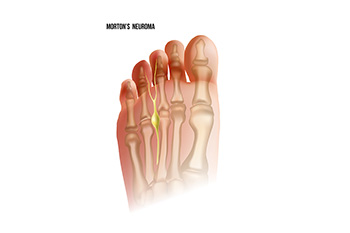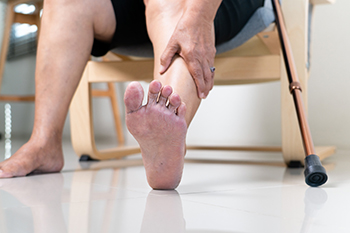Items filtered by date: November 2024
Causes of Nerve Pain in the Feet

Nerve pain in the feet, such as Baxter’s neuropathy and Morton’s neuroma, can cause significant discomfort and difficulty walking. Baxter’s neuropathy occurs when the lateral plantar nerve in the heel becomes compressed, leading to sharp, burning, or tingling pain in the bottom of the foot. Morton’s neuroma, on the other hand, is a thickening of tissue surrounding the nerve between the toes, often causing pain, numbness, or a feeling of walking on a pebble. Both conditions are more common in older adults due to age-related changes in the feet, such as reduced circulation or factors that affect nerve health, such as wearing tight shoes, arthritis, or diabetes. Treatment for both conditions includes wearing proper footwear, using custom orthotics, taking anti-inflammatory medications, and performing targeted exercises. In severe cases, injections or surgery may be necessary. If you are experiencing persistent foot pain, it is suggested that you schedule an appointment with a podiatrist for a proper diagnosis and tailored treatment plan.
Neuropathy
Neuropathy can be a potentially serious condition, especially if it is left undiagnosed. If you have any concerns that you may be experiencing nerve loss in your feet, consult with Darren Day, DPM from Hawaii. Our doctor will assess your condition and provide you with quality foot and ankle treatment for neuropathy.
What Is Neuropathy?
Neuropathy is a condition that leads to damage to the nerves in the body. Peripheral neuropathy, or neuropathy that affects your peripheral nervous system, usually occurs in the feet. Neuropathy can be triggered by a number of different causes. Such causes include diabetes, infections, cancers, disorders, and toxic substances.
Symptoms of Neuropathy Include:
- Numbness
- Sensation loss
- Prickling and tingling sensations
- Throbbing, freezing, burning pains
- Muscle weakness
Those with diabetes are at serious risk due to being unable to feel an ulcer on their feet. Diabetics usually also suffer from poor blood circulation. This can lead to the wound not healing, infections occurring, and the limb may have to be amputated.
Treatment
To treat neuropathy in the foot, podiatrists will first diagnose the cause of the neuropathy. Figuring out the underlying cause of the neuropathy will allow the podiatrist to prescribe the best treatment, whether it be caused by diabetes, toxic substance exposure, infection, etc. If the nerve has not died, then it’s possible that sensation may be able to return to the foot.
Pain medication may be issued for pain. Electrical nerve stimulation can be used to stimulate nerves. If the neuropathy is caused from pressure on the nerves, then surgery may be necessary.
If you have any questions, please feel free to contact our offices located in Honolulu and Kahuku, HI . We offer the newest diagnostic and treatment technologies for all your foot care needs.
Ingrown Toenails and the Winograd Procedure

Ingrown toenails occur when the edges of a toenail grow into the surrounding skin, leading to pain, redness, and swelling. Common causes include improper nail trimming, tight footwear, and foot injuries. Symptoms include throbbing pain and discomfort, especially when wearing shoes. Treatment typically begins with conservative measures like soaking the foot and using roomy shoes. However, for persistent cases, the Winograd procedure may be necessary. This surgical method involves removing the ingrown portion of the nail and the underlying tissue to prevent the nail from growing back incorrectly. The procedure is usually performed under local anesthesia, minimizing discomfort and ensuring a quick recovery. A podiatrist specializes in diagnosing and treating ingrown toenails, providing personalized care and expert guidance. If you are experiencing symptoms, it is suggested that you make an appointment with a podiatrist. They can offer effective treatments, including the Winograd procedure, to relieve your pain and restore your foot health.
Ingrown toenails may initially present themselves as a minor discomfort, but they may progress into an infection in the skin without proper treatment. For more information about ingrown toenails, contact Darren Day, DPM of Hawaii. Our doctor can provide the care you need to keep you pain-free and on your feet.
Ingrown Toenails
Ingrown toenails are caused when the corner or side of a toenail grows into the soft flesh surrounding it. They often result in redness, swelling, pain, and in some cases, infection. This condition typically affects the big toe and may recur if it is not treated properly.
Causes
- Improper toenail trimming
- Genetics
- Improper shoe fitting
- Injury from pedicures or nail picking
- Abnormal gait
- Poor hygiene
You are more likely to develop an ingrown toenail if you are obese, have diabetes, arthritis, or have any fungal infection in your nails. Additionally, people who have foot or toe deformities are at a higher risk of developing an ingrown toenail.
Symptoms
Some symptoms of ingrown toenails are redness, swelling, and pain. In rare cases, there may be a yellowish drainage coming from the nail.
Treatment
Ignoring an ingrown toenail can have serious complications. Infections of the nail border can progress to a deeper soft-tissue infection, which can then turn into a bone infection. You should always speak with your podiatrist if you suspect you have an ingrown toenail, especially if you have diabetes or poor circulation.
If you have any questions, please feel free to contact our offices located in Honolulu and Kahuku, HI . We offer the newest diagnostic and treatment technologies for all your foot care needs.
Elderly Foot and Ankle Pain

In older adults, foot and ankle pain is common. Pain originating in the feet often includes arthritis, bunions, and plantar fasciitis, which develop due to joint wear, inflammation, or tissue strain. Conversely, pain can also start outside the feet from nerve compression in the spine or hip arthritis, which can radiate down to the feet and cause discomfort. Aging naturally changes foot structure. Fat pads on the soles are thin, making feet more vulnerable to pressure, skin becomes drier and less elastic, and ligaments may stretch, causing flat feet or instability. Treatment often includes supportive, well-fitted shoes and custom orthotics to reduce strain. In more severe cases, injections, like corticosteroids, reduce inflammation. Surgery may be necessary to correct structural issues or relieve persistent pain. If you are elderly and experience foot or ankle pain, it is suggested that you schedule an appointment with a podiatrist for a proper diagnosis and treatment.
Proper foot care is something many older adults forget to consider. If you have any concerns about your feet and ankles, contact Darren Day, DPM from Hawaii. Our doctor can provide the care you need to keep you pain-free and on your feet.
The Elderly and Their Feet
As we age we start to notice many changes in our body, but the elder population may not notice them right away. Medical conditions may prevent the elderly to take notice of their foot health right away. Poor vision is a lead contributor to not taking action for the elderly.
Common Conditions
- Neuropathy – can reduce feeling in the feet and can hide many life-threatening medical conditions.
- Reduced flexibility – prevents the ability of proper toenail trimming, and foot cleaning. If left untreated, it may lead to further medical issues.
- Foot sores – amongst the older population can be serious before they are discovered. Some of the problematic conditions they may face are:
- Gouging toenails affecting nearby toe
- Shoes that don’t fit properly
- Pressure sores
- Loss of circulation in legs & feet
- Edema & swelling of feet and ankles
Susceptible Infections
Diabetes and poor circulation can cause general loss of sensitivity over the years, turning a simple cut into a serious issue.
If you have any questions please feel free to contact our offices located in Honolulu and Kahuku, HI . We offer the newest diagnostic and treatment technologies for all your foot and ankle needs.
Reminder: When Was the Last Time...?
Managing Athlete’s Foot

Athlete's foot, or tinea pedis, is a fungal infection caused by the same dermatophytes responsible for ringworm and jock itch. It typically affects the skin between the toes. Athlete’s foot thrives in warm, humid environments, making it common among athletes and people who use shared facilities like gyms and pools. Moist socks and shoes can encourage the growth of these fungi. Symptoms often include itching, burning, redness and peeling skin, especially between the toes, and in some cases, blisters may form. While antifungal creams can be effective, persistent or severe symptoms may need medical attention. If you experience intense pain, swelling, or signs of a secondary bacterial infection, such as increased redness or discharge, it is suggested that you schedule an appointment with a podiatrist. They can provide an accurate diagnosis and personalized treatment options.
Athlete’s foot is an inconvenient condition that can be easily reduced with the proper treatment. If you have any concerns about your feet and ankles, contact Darren Day, DPM from Hawaii. Our doctor will treat your foot and ankle needs.
Athlete’s Foot: The Sole Story
Athlete's foot, also known as tinea pedis, can be an extremely contagious foot infection. It is commonly contracted in public changing areas and bathrooms, dormitory style living quarters, around locker rooms and public swimming pools, or anywhere your feet often come into contact with other people.
Solutions to Combat Athlete’s Foot
- Hydrate your feet by using lotion
- Exfoliate
- Buff off nails
- Use of anti-fungal products
- Examine your feet and visit your doctor if any suspicious blisters or cuts develop
Athlete’s foot can cause many irritating symptoms such as dry and flaking skin, itching, and redness. Some more severe symptoms can include bleeding and cracked skin, intense itching and burning, and even pain when walking. In the worst cases, Athlete’s foot can cause blistering as well. Speak to your podiatrist for a better understanding of the different causes of Athlete’s foot, as well as help in determining which treatment options are best for you.
If you have any questions please feel free to contact our offices located in Honolulu and Kahuku, HI . We offer the newest diagnostic and treatment technologies for all your foot and ankle needs.






